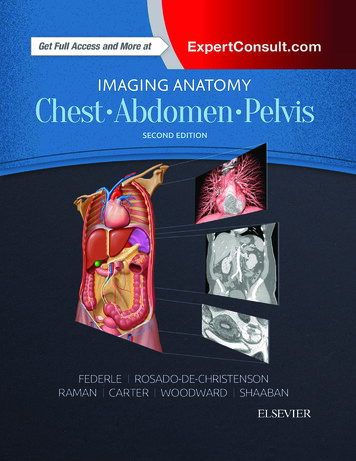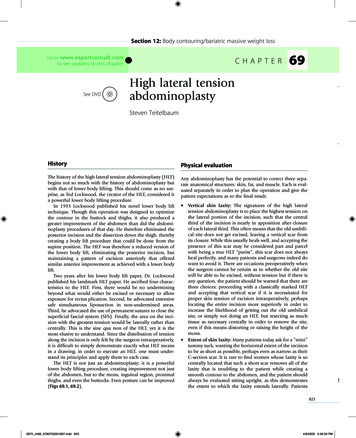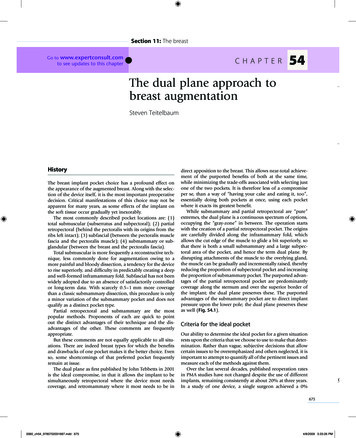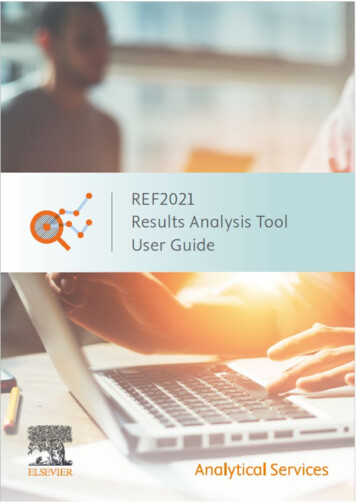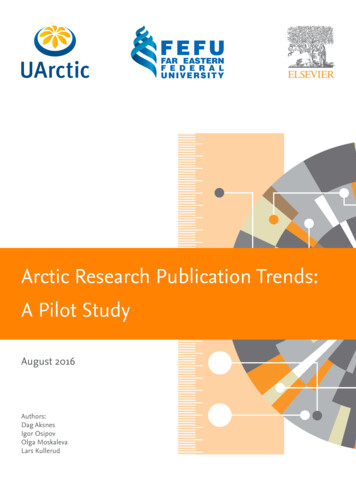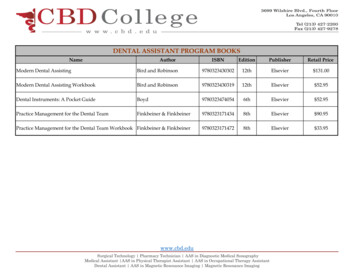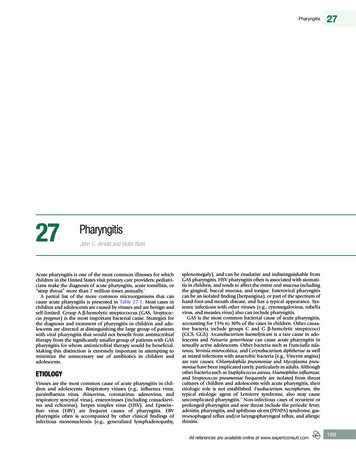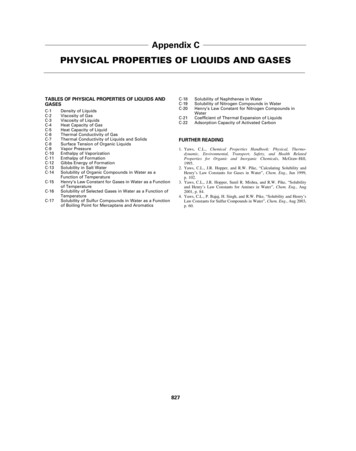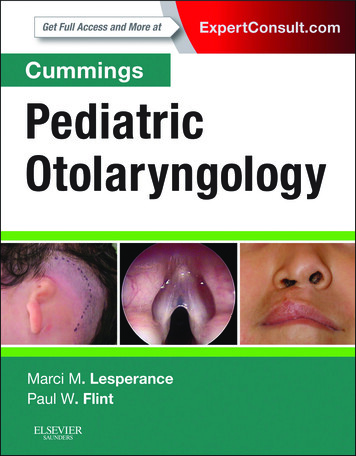
Transcription
Expert CONSULTDon’t Forget Your Online Access toElsevier ExpertConsult.comEnhanced eBooks for medical professionalsCompatible with PC, Mac , most mobile devices, and eReaders, Expert Consultallows you to browse, search, and interact with this title – online and offline.Redeem your PIN at expertconsult.com today!PIN REDEMPTION INSTRUCTIONSStart using these innovative features today:s Seamless, real-time integration between devicess Straightforward navigation and searchs Notes and highlights sharing with other usersthrough social medias Enhanced images with annotations, labels, andhot spots for zooming on specific details *s Live streaming video and animations *s Self-assessment tools such as questionsembedded within the text and multiple-formatquizzes ** some features vary by title1.2.3.4.5.Login or Sign Up at ExpertConsult.comScratch off your PIN code belowEnter PIN into the “Redeem a Book Code” boxClick “Redeem”Go to “My Library”Use of the current edition of the electronic version of this book (eBook) is subject to the terms of the nontransferable, limitedlicense granted on ExpertConsult.com. Access to the eBook is limited to the first individual who redeems the PIN, locatedon the inside cover of this book, at ExpertConsult.com and may not be transferred to another party by resale, lending, orother means.For technical assistance: Email: online.help@elsevier.com;Call: within the US and Canada: 800-401-9962;outside the US and Canada: 1-314-447-8200
CummingsPediatric Otolaryngology
This page intentionally left blank
CummingsPediatricOtolaryngologyMarci M. Lesperance, MDProfessor, Department of Otolaryngology–Headand Neck SurgeryChief, Division of Pediatric OtolaryngologyUniversity of Michigan Health SystemAnn Arbor, MichiganPaul W. Flint, MDProfessor and ChairDepartment of Otolaryngology–Head andNeck SurgeryOregon Health & Science UniversityPortland, Oregon
1600 John F. Kennedy Blvd.Ste 1800Philadelphia, PA 19103-2899CUMMINGS PEDIATRIC OTOLARYNGOLOGYCopyright 2015 by Saunders, an imprint of Elsevier Inc.ISBN: 978-0-323-35671-8No part of this publication may be reproduced or transmitted in any form or by any means,electronic or mechanical, including photocopying, recording, or any information storage andretrieval system, without permission in writing from the publisher. Details on how to seekpermission, further information about the Publisher’s permissions policies and our arrangementswith organizations such as the Copyright Clearance Center and the Copyright Licensing Agency,can be found at our website: www.elsevier.com/permissions.This book and the individual contributions contained in it are protected under copyright by thePublisher (other than as may be noted herein).NoticesKnowledge and best practice in this field are constantly changing. As new research andexperience broaden our understanding, changes in research methods, professional practices,or medical treatment may become necessary.Practitioners and researchers must always rely on their own experience and knowledge inevaluating and using any information, methods, compounds, or experiments described herein.In using such information or methods they should be mindful of their own safety and thesafety of others, including parties for whom they have a professional responsibility.With respect to any drug or pharmaceutical products identified, readers are advisedto check the most current information provided (i) on procedures featured or (ii) bythe manufacturer of each product to be administered, to verify the recommended doseor formula, the method and duration of administration, and contraindications. It is theresponsibility of practitioners, relying on their own experience and knowledge of theirpatients, to make diagnoses, to determine dosages and the best treatment for each individualpatient, and to take all appropriate safety precautions.To the fullest extent of the law, neither the Publisher nor the authors, contributors, oreditors, assume any liability for any injury and/or damage to persons or property as a matterof products liability, negligence or otherwise, or from any use or operation of any methods,products, instructions, or ideas contained in the material herein.Library of Congress Cataloging-in-Publication DataISBN: 978-0-323-35671-8Senior Content Strategist: Belinda KuhnContent Development Manager: Lucia GunzelPublishing Services Manager: Patricia TannianSenior Project Manager: Carrie StetzDesign Direction: Ellen Zanolle, Ryan CookPrinted in CanadaLast digit is the print number:987 654321
ContributorsFuad M. Baroody, MDProfessor of SurgerySection of Otolaryngology–Head and Neck SurgeryProfessor of PediatricsUniversity of Chicago MedicineChicago, IllinoisShethal Bearelly, MDResident PhysicianDepartment of Otolaryngology–Head and Neck SurgeryUniversity of California–San FranciscoSan Francisco, CaliforniaAmit D. Bhrany, MDAssistant ProfessorDepartment of Otolaryngology–Head and Neck SurgeryUniversity of WashingtonSeattle, WashingtonScott Brietzke, MD, MPHDirector of Pediatric Otolaryngology and Sleep SurgeryDepartment of OtolaryngologyWalter Reed National Military Medical Center;Associate Professor of SurgeryDepartment of SurgeryUniformed Services University of the Health SciencesBethesda, MarylandJennifer Veraldi Brinkmeier, MDClinical LecturerDepartment of Otolaryngology–Head and Neck SurgeryDivision of Pediatric OtolaryngologyUniversity of MichiganAnn Arbor, MichiganDavid J. Brown, MDAssociate Professor Department of Otolaryngology–Headand Neck SurgeryDivision of Pediatric OtolaryngologyUniversity of MichiganAnn Arbor, MichiganMargaretha L. Casselbrandt, MD, PhDDirectorDivision of Pediatric OtolaryngologyChildren’s Hospital of PittsburghUniversity of Pittsburgh School of MedicinePittsburgh, PennsylvaniaKenny Chan, MDProfessor of OtolaryngologyUniversity of Colorado School of MedicineChiefPediatric OtolaryngologyChildren’s Hospital ColoradoAurora, ColoradoEunice Y. Chen, MD, PhDAssistant ProfessorDepartments of Surgery and PediatricsDartmouth Hitchcock Medical CenterLebanon, New HampshireAlan G. Cheng, MDAssistant Professor of Otolaryngology–Headand Neck SurgeryAssistant Professor of PediatricsAkiko Yamazaki and Jerry Yang Faculty ScholarChildren’s HealthStanford University School of MedicineStanford, CaliforniaTendy Chiang, MDAssistant ProfessorDepartment of Pediatric OtolaryngologyChildren’s Hospital ColoradoAurora, ColoradoSukgi S. Choi, MDDirector and Eberly ChairDepartment of Pediatric OtolaryngologyChildren’s Hospital of Pittsburgh of UPMCProfessorDepartment of OtolaryngologyUniversity of Pittsburgh School of MedicinePittsburgh, PennsylvaniaRobert Chun, MDAssociate ProfessorAssociate Residence Program DirectorChildren’s Hospital of WisconsinDepartment of OtolaryngologyMedical College of WisconsinMilwaukee, WisconsinRobin T. Cotton, MDProfessorDepartment of Otolaryngology–Head and Neck SurgeryUniversity of Cincinnati College of MedicineDepartment of Pediatric Otolaryngology–Head and NeckSurgeryCincinnati Children’s HospitalCincinnati, OhioSam J. Daniel, MDCMDirectorDepartment of Pediatric OtolaryngologyMontreal Children’s Hospital;Associate ChairDepartment of Pediatric SurgeryMcGill UniversityMontreal, Quebec, Canadav
viCONTRIBUTORSJoshua C. Demke, MDAssistant ProfessorFacial Plastic and Reconstructive SurgeryDirectorWest Texas Craniofacial Center of ExcellenceTexas Tech Health Sciences CenterLubbock, TexasFrançoise Denoyelle, MD, PhDProfessorDepartment of Pediatric Otolaryngology and Headand Neck SurgeryNecker Children’s HospitalAPHPParis V UniversityParis, FranceCraig S. Derkay, MDProfessor and Vice-ChairmanDepartment of Otolaryngology–Head and Neck SurgeryEastern Virginia Medical School;DirectorDepartment of Pediatric OtolaryngologyChildren’s Hospital of the King’s DaughtersNorfolk, VirginiaRavindhra G. Elluru, MD, PhDAssociate ProfessorDivision of Pediatric OtolaryngologyCincinnati Children’s Hospital;Associate ProfessorDepartment of OtolaryngologyUniversity of Cincinnati College of MedicineCincinnati, OhioMarcela Fandiño Cardenas, MD, MScPediatric OtolaryngologistFundación Cardiovascular de ColombiaBucaramanga, ColombiaRussell A. Faust, MD, PhDAssociate Professor of PediatricsWayne State University School of MedicineAssistant Professor of Oral BiologyOhio State University College of DentistryColumbus, OhioNira A. Goldstein, MD, MPHProfessor of Clinical OtolaryngologyDivision of Pediatric OtolaryngologyState University of New YorkDownstate Medical CenterNew York, New YorkGlenn Green, MDAssociate ProfessorDepartment of Otolaryngology–Head and Neck SurgeryUniversity of MichiganAnn Arbor, MichiganHeike Gries, MD, PhDAssistant ProfessorDepartment of Pediatric AnesthesiologyOregon Health & Science UniversityPortland, OregonJaynee A. Handelsman, PhDDirectorPediatric AudiologyClinical Assistant ProfessorDepartment of OtolaryngologyMott Children’s HospitalUniversity of Michigan Health SystemAnn Arbor, MichiganAmer Heider, MDAssistant ProfessorDepartment of PathologyUniversity of Michigan Health SystemAnn Arbor, MichiganStacey L. Ishman, MD, MPHSurgical DirectorUpper Airway CenterAssociate ProfessorCincinnati Children’s Hospital Medical CenterUniversity of CincinnatiCincinnati, OhioRobert K. Jackler, MDSewall Professor and ChairDepartment of Otolaryngology–Head and Neck SurgeryProfessorDepartments of Neurosurgery and SurgeryStanford University School of MedicineStanford, CaliforniaAlyssa A. Kanaan, MDFellowPediatric OtolaryngologyDepartment of Pediatric OtolaryngologyMontreal Children’s HospitalMcGill UniversityMontreal, Quebec, CanadaJessica Kepchar, DODepartment of OtolaryngologyBayne-Jones Army Community HospitalFort Polk, LouisianaJeffrey Koh, MD, MBAProfessorDepartment of Anesthesiology and Perioperative MedicineChief, Division of Pediatric Anesthesiologyand Pain ManagementOregon Health and Science UniversityPortland, OregonFrederick K. Kozak, MDHead, Division of Pediatric OtolaryngologyMedical/Surgical DirectorCochlear Implant ProgramB.C. Children’s Hospital;Clinical Professor and Residency Program DirectorDivision of OtolaryngologyDepartment of SurgeryUniversity of British ColumbiaVancouver, British Columbia, CanadaMaureen A. Lefton-Greif, PhD, CCC-SLPAssociate ProfessorDepartments of Pediatrics, Otolaryngology–Head and NeckSurgery, and Physical Medicine & RehabilitationJohns Hopkins University School of MedicineBaltimore, Maryland
CONTRIBUTORSMarci M. Lesperance, MDProfessor, Department of OtolaryngologyChief, Division of Pediatric OtolaryngologyUniversity of Michigan Health SystemAnn Arbor, MichiganRichard J. Noel, MD, PhDDivision ChiefPediatric Gastroenterology, Hepatology, and NutritionDuke University Medical CenterDurham, North CarolinaEllen M. Mandel, MDAssociate ProfessorDepartment of OtolaryngologyUniversity of PittsburghPittsburgh, PennsylvaniaRichard Ohye, MDHeadSection of Pediatric Cardiovascular SurgeryDepartment of Cardiac SurgeryUniversity of MichiganAnn Arbor, MichiganJ. Scott McMurray, MDAssociate ProfessorDepartments of Surgery and PediatricsUniversity of Wisconsin School of Medicineand Public HealthAmerican Family Children’s HospitalMadison, WisconsinJeremy D. Meier, MDAssistant ProfessorDivision of Otolaryngology–Head and Neck SurgeryUniversity of Utah School of MedicineDepartment of Pediatric OncologyPrimary Children’s HospitalSalt Lake City, UtahAnna H. Messner, MDProfessor and Vice ChairDepartment of Otolaryngology–Head and Neck SurgeryStanford UniversityStanford, CaliforniaAnna Meyer, MDAssistant ProfessorDepartment of Otolaryngology–Head and NeckSurgeryUniversity of California–San FranciscoSan Francisco, CaliforniaHenry A. Milczuk, MDAssociate Professor and ChiefDivision of Pediatric OtolaryngologyOregon Health and Science UniversityPortland, OregonHarlan Muntz, MDProfessor of OtolaryngologyDepartment of SurgeryUniversity of Utah School of MedicinePrimary Children’s Medical CenterSalt Lake City, UtahCraig S. Murakami, MDClinical ProfessorFacial Plastic and Reconstructive SurgeryUniversity of WashingtonDepartment of OtolaryngologyVirginia Mason Medical CenterSeattle, WashingtonMarc Nelson, MDAssociate ProfessorDepartment of OtolaryngologyPediatric ENT CenterAkron Children’s HospitalAkron, OhioviiJuan Camilo Ospina, MDPediatric OtolaryngologistHeadDivision of Otorhinolaryngology and Maxillofacial SurgeryHospital Universitario San Ignacio;Associate ProfessorPontificia Universidad JaverianaBogota, ColombiaJonathan A. Perkins, DOProfessorDepartment of Otolaryngology–Head and Neck SurgeryUniversity of Washington School of MedicineDirectorVascular Anomalies ProgramSeattle Children’s HospitalSeattle, WashingtonWilliam P. Potsic, MD, MMMEmeritus Professor of Otorhinolaryngology–Head and NeckSurgeryPerelman School of Medicine at the University ofPennsylvaniaPhiladelphia, PennsylvaniaMark D. Rizzi, MDAssistant ProfessorDepartment of Clinical Otolaryngology–Head and NeckSurgeryPerelman School of Medicine at the University ofPennsylvaniaDivision of Pediatric OtolaryngologyChildren’s Hospital of PhiladelphiaPhiladelphia, PennsylvaniaKristina W. Rosbe, MDProfessor and Director of Pediatric OtolaryngologyDepartment of Otolaryngology–Head and Neck SurgeryUniversity of California–San FranciscoSan Francisco, CaliforniaCara Sauder, MA, CCC-SLPSpeech-Language PathologistUniversity of New Mexico HospitalAlbuquerque, New MexicoScott R. Schoem, MDDirectorDepartment of OtolaryngologyConnecticut Children’s Medical CenterHartford, Connecticut;Clinical ProfessorDepartment of OtolaryngologyUniversity of Connecticut School of Health SciencesFarmington, Connecticut
viiiCONTRIBUTORSKathleen C.Y. Sie, MDProfessorDepartment of Otolaryngology–Head and Neck SurgeryUniversity of Washington School of MedicineDirectorChildhood Communication CenterSeattle Children’s HospitalSeattle, WashingtonMarshall E. Smith, MDProfessorDivision of Otolaryngology–Head and Neck SurgeryUniversity of Utah School of Medicine;Attending Physician and Medical DirectorVoice Disorders ClinicPrimary Children’s Medical CenterUniversity HospitalSalt Lake City, UtahVeronica C. Swanson, MD, MBAAssociate DirectorDepartment of AnesthesiologyChiefPediatric Cardiac AnesthesiologySt. Christopher’s Hospital for Children;Associate ProfessorDepartments of Anesthesiology and PediatricsDrexel University College of Medicine and DentistryPhiladelphia, PennsylvaniaPravin A. Taneja, MD, MBAProgram DirectorPediatric Anesthesia FellowshipDepartment of AnesthesiologySt. Christopher’s Hospital for Children;Assistant ProfessorDepartment of AnesthesiologyDrexel University College of Medicine and DentistryPhiladelphia, PennsylvaniaSherard A. Tatum III, MDProfessorDepartments of Otolaryngology and PediatricsSUNY Upstate Medical University;Medical DirectorCleft and Craniofacial CenterGolisano Children’s HospitalSyracuse, New YorkMai Thy Truong, MDClinical Assistant ProfessorDepartment of Otolaryngology–Head and Neck SurgeryStanford UniversityStanford, CaliforniaLori A. Van Riper, PhDDepartment of Pediatric Audiology and OtolaryngologyMott Children’s HospitalUniversity of Michigan Health SystemAnn Arbor, MichiganTom D. Wang, MDProfessor & ChiefDivision of Facial Plastic and Reconstructive SurgeryOregon Health and Science UniversityPortland, OregonRalph F. Wetmore, MDE. Mortimer Newlin Professor of Pediatric OtolaryngologyPerelman School of Medicine at the University ofPennsylvaniaChiefDivision of Pediatric OtolaryngologyThe Children’s Hospital of PhiladelphiaPhiladelphia, PennsylvaniaRobert F. Yellon, MDProfessorDepartment of OtolaryngologyUniversity of Pittsburgh School of MedicineDirector of ENT Clinical ServicesDepartment of Pediatric OtolaryngologyChildren’s Hospital of Pittsburgh of UPMCPittsburgh, PennsylvaniaGeorge H. Zalzal, MDChiefDivision of OtolaryngologyChildren’s National Medical CenterProfessor of Otolaryngology and PediatricsGeorge Washington University School of Medicineand Health SciencesWashington, DC
PrefaceFor most otolaryngologists, the evaluation and management ofchildren with otolaryngologic disorders constitute an important and often large part of their clinical practice. Yet, recentyears have seen great changes in pediatric otolaryngology. Tomeet this need, we are very pleased to offer the first edition ofCummings Pediatric Otolaryngology.It has been said that pediatric otolaryngology encompassesone third simple problems in healthy children, one thirdsimple problems in children with comorbidities, and one thirdtertiary clinical problems occurring in healthy and medicallycomplex children. Treatment advances have greatly improvedsurvival for many childhood conditions such as early prematurity, cancer, and congenital heart disease, to name only a few.This text is focused on the latter two categories to assist thepracticing otolaryngologist in keeping up to date on theseessential topics. Reflecting the growing emphasis on multidisciplinary care of the complex pediatric otolaryngology patient,several chapters feature authors from multiple disciplines,including diagnosis and management of tracheal anomaliesand tracheal stenosis, gastroesophageal reflux and laryngealdisease, aspiration and swallowing disorders, and pediatrichead and neck malignancies.This book also features a chapter on pediatric infectiousdisease, describing a practical approach for common clinicalproblems, as well as evaluation and management of theinfant airway, a topic that is the sine qua non of pediatricotolaryngology.With increasing recognition of the impact of pediatric sleepdisorders on children’s health, the chapter on pediatric obstructive sleep apnea is complemented by a chapter on pediatricsleep disorders to address the otolaryngologist’s growing needto understand sleep disorders other than obstructive sleepapnea.Our goal of this first edition of Cummings Pediatric Otolaryngology is to provide a lasting resource for students, residents,fellows, and practicing physicians alike and to reflect thedynamic and evolving field of pediatric otolaryngology.ix
This page intentionally left blank
Contents1 13Congenital Malformations of the Inner Ear, 170General Considerations in PediatricOtolaryngology, 114Microtia Reconstruction, 188Developmental Anatomy, 1115Evaluation and Management of CongenitalAural Atresia, 196SECTION 1GENERALJ. Scott McMurray2Eunice Y. Chen Kathleen C.Y. Sie3Anesthesia in Pediatric Otolaryngology, 214Nonobstructive Pediatric Sleep Disorders, 395Evaluation and Management of PediatricObstructive Sleep Apnea, 44Veronica C. Swanson Pravin A. Taneja Heike Gries Jeffrey KohJessica Kepchar Scott BrietzkeSECTION 27 CRANIOFACIALCharacteristics of Normal and AbnormalPostnatal Craniofacial Growth andDevelopment, 55Acute Otitis Media and Otitis Mediawith Effusion, 209SECTION 4 INFECTIONS ANDINFLAMMATION17Pediatric Chronic Rhinosinusitis, 22818Pediatric Infectious Disease, 235Fuad M. BaroodyAnna MeyerSECTION 5 HEAD AND NECKDifferential Diagnosis of Neck Masses, 245Craniofacial Surgery for Congenital andAcquired Deformities, 8120Vascular Anomalies of the Head and Neck, 25521Pediatric Head and Neck Malignancies, 27222Salivary Gland Disease in Children, 293Cleft Lip and Palate, 1059Velopharyngeal Dysfunction, 123Tom D. Wang Henry A. MilczukHarlan Muntz Marshall E. Smith Cara Sauder Jeremy D. MeierCongenital Malformations of the Noseand Nasopharynx, 134Ravindhra G. ElluruTendy Chiang Kenny H. ChanEarly Detection and Diagnosis of InfantHearing Impairment, 160Jaynee A. Handelsman Lori A. Van Riper Marci M. LesperanceMark D. Rizzi Ralph F. Wetmore William P. PotsicJonathan A. PerkinsJennifer Veraldi Brinkmeier Amer Heider David J. BrownSam J. Daniel Alyssa A. KanaanSECTION 6 PHARYNX, LARYNX, TRACHEA,AND ESOPHAGUS23Pediatric Facial Fractures, 146SECTION 3 HEARING LOSS ANDPEDIATRIC OTOLOGY121619811Robert F. Yellon Françoise DenoyelleFrederick K. Kozak Juan Camilo Ospina Marcela Fandiño CardenasJoshua C. Demke Sherard A. Tatum III10Kathleen C.Y. Sie Amit D. Bhrany Craig S. MurakamiMargaretha L. Casselbrant Ellen M. MandelNira A. Goldstein6Alan G. Cheng Robert K. JacklerEvaluation and Management of the PediatricAirway, 309Mai Thy Truong Anna H. Messner24Voice Disorders, 32325Recurrent Respiratory Papillomatosis, 33226Glottic and Subglottic Stenosis, 348Sukgi S. Choi George H. ZalzalCraig S. Derkay Russell A. FaustGeorge H. Zalzal Robin T. Cottonxi
xiiCONTENTS27Pediatric Tracheal Anomalies, 36128Aerodigestive Foreign Bodies andCaustic Ingestions, 374Marc Nelson Glenn Green Richard G. OhyeScott R. Schoem Kristina W. Rosbe Shethal Bearelly29Laryngopharyngeal and Gastroesophageal RefluxDisease and Eosinophilic Esophagitis, 385Robert Chun Richard J. Noel30Aspiration and Swallowing Disorders, 390David J. Brown Maureen A. Lefton-Greif Stacey L. Ishman
SECTION 1 GENERALGeneral Considerations inPediatric Otolaryngology1J. Scott McMurrayKey Points Children are physiologically different from adults. Familiarity with these differences is required forsafe management of the medical and surgical problems of children.Providing optimal pediatric care requires attention to the child as a patient and to the adults as guardians.Involving the child in play may alleviate anxiety regarding procedures in the physical examination.With practice, physical examination can be conducted in an expedient fashion and will be relativelypainless for the child yet complete for the surgeon.Management of the pediatric otolaryngology patient often requires a multidisciplinary team approach.Pediatric otolaryngology has developed over the years into aformal subspecialty of otolaryngology head and neck surgery,led by surgeons who had specific interests in the care of children. What makes pediatric otolaryngology distinct from itsparent discipline of otolaryngology head and neck surgery arethe special problems that present in children with an oftenunique approach to their management.The specific problems that a pediatric otolaryngologistmay encounter include airway disorders that present congenitally or iatrogenically, swallowing disorders that may changewith growth and development, head and neck tumors in children and infants, hearing loss that may be congenital oracquired, and other congenital anomalies that may present inthe head and neck (Figs. 1-1 through 1-6). As a subspecialty ofFIGURE 1-1. Telescopic operative laryngoscopy of an infant larynx with alaryngotracheal cleft. A feeding tube can be seen passing into the esophaguswith the laryngeal cleft extending inferiorly through the cricoid to the cervicalesophagus.otolaryngology head and neck surgery, the surgical techniquesare not necessarily different, but the differential diagnosis, theapproach to the child and parent, and the overall surgicalmanagement may diverge significantly. Not all enjoy treatingboth child and parent, but for those who do, pediatric otolaryngology is exceedingly rewarding. The specific problems thatchildren may present with in the head and neck are oftenreadily correctable, such that children may achieve their fullpotential as they grow and develop.FIGURE 1-2. Oropharyngeal view during tonsillectomy of massive tonsils.These so-called kissing tonsils are causing complete obstruction of the oropharynx. This child had severe obstructive sleep apnea.1
2CUMMINGS PEDIATRIC OTOLARYNGOLOGYFIGURE 1-5. Intubated newborn with a large lingual cyst. This cyst wasidentified prenatally by fetal ultrasound, and the airway was secured with theaid of maternal fetal circulation as a bridge during an ex utero intrapartumtreatment procedure. The cyst was a bronchogenic duplication cyst and wasexcised at the time of delivery to avoid tracheotomy.FIGURE 1-3. Chest radiograph of a young child with a radiopaque metallicnail in the right main bronchus.For many practitioners, there is no greater reward thanhelping children afflicted with illness. Pediatric otolaryngologyhas developed as a subspecialty as a bridge between pediatricmedicine and the surgical discipline of otolaryngology. Nearlyevery otolaryngologist will treat children during his or her professional career, and an estimated 25% to 50% of a generalFIGURE 1-4. Photograph of the upper maxilla of a child with a single centralmega-incisor, which is associated with piriform aperture stenosis. This childhad respiratory distress as a newborn from a narrowed nasal airway at thepiriform aperture, and the single central mega-incisor confirmed the diagnosis of piriform aperture stenosis.otolaryngologist’s practice may be related to pediatric problems. Pediatric otolaryngology has therefore become an important part of all training programs in this field.As the saying goes, children are not simply little adults.Often unique approaches are required for their evaluation,diagnosis, and management. Although the child is of primeconcern, the parents—as the child’s guardians, who must makedecisions regarding the ultimate treatment options—also mustbe kept informed and must be approached with compassion.This is obvious to nearly everyone who has had to make medicaldecisions for a loved one, but it may not be as obvious to thoseFIGURE 1-6. Fetal magnetic resonance imaging shows a large lymphaticmalformation in the floor of the mouth and tongue. The head of the fetus isup with the nose pointing to the left. Planning for the management of theairway by a multidisciplinary team was required. The child was born by anex utero intrapartum treatment (EXIT) procedure using maternal fetal circulation as a bridge to securing the airway. Although the child was successfullyintubated during the EXIT procedure, a tracheotomy was inserted as thediffuse lymphatic malformation was found to also involve the supraglottis,which caused severe airway dysfunction.
1 GENERAL CONSIDERATIONS IN PEDIATRIC OTOLARYNGOLOGYwho have not. The love for and emotional bond with a childmay make even the most calm and rational person unable tocomprehend events and medical explanations. It is up to thesurgeon to monitor and modify his or her approach and explanations to both the child and the parent. This is not always aneasy task, but it is one that is highly rewarding.Smaller and more premature neonates are surviving, andsicker children are recovering from significant illnesses, asneonatal and pediatric intensive care units and the skills ofthe physicians who care for children continue to advance.This development has led to a demand for practitioners wellversed in the management of disorders encountered in thispopulation—namely, intubation trauma, bronchoesophagealprocesses, infectious disease, tumors, and congenital malformations. A multidisciplinary approach is often required. Agreement among the pediatric specialists and with the generalpediatrician is important and represents a third layer of communication that is required for successful treatment of the childand family.Physiologic differences among infants, children, and adultshave occupied major research efforts and constitute the subjectof complete textbooks. This chapter outlines basic differencesrelevant to the practice of otolaryngology along with somerelated considerations. In the following discussion, the materialpresented for each of the major body systems is intended as ageneral introduction to be used as a starting point for furtherinvestigation.RESPIRATORY SYSTEMCONTROL OF VENTILATIONEmergence from an underwater world, in which the childrelied on placental exchange of gases and nutrition, inducestremendous changes in the neonate’s physiology and anatomy.Some of these changes occur rapidly at birth, whereas othersproceed more slowly. These significant changes can complicateinterpretation of the neonate’s problems. In particular, theassessment of the neonate’s ventilation may be difficult. Interventions used to obtain measurements, such as placement of afacemask or insertion of a laryngotracheal tube, may inducesignificant changes in ventilation. Measurements of ventilationto assess respiratory drive also depend on the assumption thatthe respiratory muscles are capable of converting this drive intowork—which is not always the case in infants and neonates.Muscle fibers may be classified as type I fibers, which are slowtwitch, highly oxidative, and fatigue resistant, or type II fibers,which are fast twitch and easily fatigable. Newborns have apaucity of type I muscle fibers but develop them shortly afterbirth. The muscle fibers in the diaphragm of a preterm infantare composed of less than 10% of type I fibers, whereas themuscle fibers of a full-term infant may be 30% type I fibers; thepercentage of type I fibers increases to 55%, the expected adultlevel, during the first year of life. Preterm infants are moreprone to respiratory fatigue, although this predilection disappears as they reach maturity.Other subtle differences in sleep patterns also affect controlof ventilation. Preterm infants spend as much as 50% to 60%of their sleep state in the rapid eye movement (REM) state.During REM sleep, the intercostal muscles are inhibited, asare most of the other skeletal muscles. This places a greaterburden on the diaphragmatic activity. Much of this activitymay be wasted because the chest wall can move paradoxicallyin the very young. This purposeless movement readily leadsto hypoventilation, increased respiratory drive, and diaphragmatic fatigue.Biochemical and reflex controls of ventilation are similarbut incompletely developed in full-term neonates when compared with adults. Neonates have a higher basal metabolic rate3than that in adults, reflected in higher ventilatory rates relativeto body mass at any given partial pressure of carbon dioxide(PaCO2). In term infants and adults, an increased PaCO2 resultsin a proportionately similar increase in ventilation; however,this concordance in response is not seen in preterm infants.Compared with full-term infants and adults, preterm infantshave a blun
on the inside cover of this book, at ExpertConsult.com and may not be transferred to another party by resale, lending, or other means. For technical assistance: Email: online.help@elsevier.com; Call: within the US and Canada: 800-401-9962; outside the US and Canada: 1-314-447-8200 .

